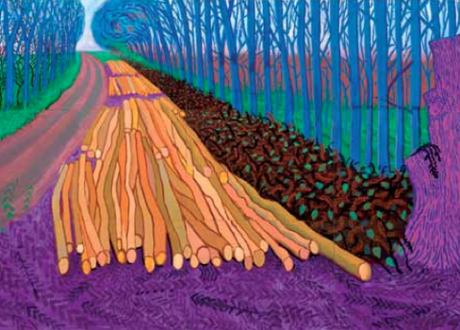
From Hockney's exhibition at the Royal Academy.
This piece was first published for Creatures of Culture.
There is something inherently cheerful about the work of David Hockney, and this latest exhibition of his paintings and other works inspired by the homely Yorkshire landscape clearly demonstrates that fact. Perhaps it is the vibrant colours that Hockney sees in everyday scenes, or perhaps it is the scale of the works, which adorn entire walls of the Royal Academy.
Either way, and if it hadn’t already, the nation has now fallen for Hockney completely. His use of British scenes instills a great sense of national pride, and the use of an iPad and cameras in his work also demonstrates a willingness to merge old techniques with modern methods to great effect.
While much of the exhibition focuses on Hockney’s newer works, completed after 2004 and in some cases only recently finished for this particular show, there are some outstanding first pieces from Hockney’s younger days. Among these, Bolton Junction (1956) is particularly notable as it shows Hockney’s early preoccupations with his homeland, trees, and a local setting. Although he may not have always portrayed this inspiration, it had clearly entered his psyche: later in the 1990s, while Hockney was living in New York, he painted several scenes of the Yorkshire countryside recalled from drives he took to visit a sick friend from memory. Despite not being painted from living scenes, North Yorkshire (1997) and The Road across the Wolds (1997) lovingly recall the rolling English hills, and the thick spreads of oil across the canvases are illustrative of Hockney’s clear skill in this medium.
However, Hockney did return in time to paint his favorite subject from observation. One room is dedicated to watercolours and oils of the paths, roads, hills and trees of unspoilt Yorkshire. In an interesting juxtaposition, we are invited to compare these techniques employed by Hockney: Whilst the oils are bold and warm, his watercolours offer a level of detail and deep tonal range.
The exhibition moves on to present the idea of the tunnel being a key motif in Hockney’s work, and indeed, in a series of paintings of a woodland tree ‘tunnel’ through different seasons, it is evident why. The tunnel form provides Hockney with numerous trees to portray, their branches and leaves in summer versus winter, and the end of the tunnel leading out onto a beautiful countryside scene. Other recurring images include scenes from Woldgate Woods, hawthorn bushes in full blossom (indeed these paintings of vivid color and strange thick clusters of blossom look almost otherworldly) and felled timber. Felled trees on Woldgate (2008- shown below) is painted across two canvases, and is remarkable due to Hockney’s color choice for translating a woodland scene: pink is the winding path through the blue-trunked trees, and in the center of the foreground a purple tree stump stands strangely tall. Also of note are several outstanding charcoal drawings made as preliminary sketches, which clearly show Hockney’s superb eye for observation.
At this point, the exhibition boldly presents an entire room under the title of The Arrival of Spring in Woldgate, East Yorkshire in 2011, featuring 52 works, some in oil and others lifted from iPad sketches made by the artist. It is these works that have sparked the most debate: is it right for Hockney to use an iPad? What value does it add or take away from his work? These questions require a personal response, and whilst initially I judged some of the pieces, when I saw the iPads themselves it became apparent that Hockney would have applied the same level of observation and execution in these works as his more traditional paintings require.
Hockney’s film montage also portrays a preoccupation to embrace modernity and apply it to his art. Here, several cameras capture the same scenes on several screens (a country lane, Hockney’s own studio, and a dance class complete with pianist in the right hand corner) but from a slightly different vantage point and view. Thus the final image is slightly broken, with elements both missing and repeated, yet totally watchable, and at times very amusing.
A final mention must go to Hockney’s recent work inspired by Claude Lorrain’s Sermon on the Mount (1656). Hockney saw Lorrain’s masterpiece in the Frick Collection, New York, and decided to make a series of his own interpretations related to the scene. The result is fascinating as Hockney experiments with a direct copy, to more abstract forms and sharp lines and shapes.
A Bigger Picture is worth all the hype, and it was a pleasure to take in Hockney’s scenes despite the crowds.
David Hockney RA: A Bigger Picture is now showing at the Royal Academy, London until 9th April 2012.

